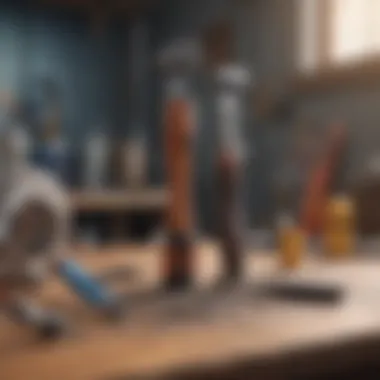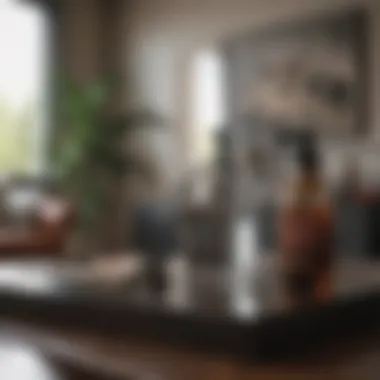Safe and Efficient Acrylic Removal Techniques


Intro
Removing acrylic materials is a task that can arise in various contexts, especially in beauty, home decor, and crafting. Whether dealing with acrylic nails or decorative items, the proper techniques for removal not only ensure safety but also protect the integrity of the underlying surface. In this article, we explore the most effective ways to remove acrylic safely and efficiently while minimizing discomfort or damage.
Understanding the various methods and best practices for acrylic removal is crucial. Many swear by home remedies or quick-fix solutions, but these can often lead to unforeseen complications, such as skin irritation or damage to the material itself. Thus, it's essential to cultivate knowledge about techniques that will serve as effective tools in navigating this process.
Artisans and DIY enthusiasts may appreciate the safety tips provided here, ensuring a more comfortable experience while engaging with crafting supplies. This comprehensive guide emphasizes methods prioritizing safety and care, highlighting common pitfalls and offering appropriate alternatives.
Safe Practices in Acrylic Removal
Before diving into specific techniques, it's vital to acknowledge that safety should always be the priority. Acrylic materials can be adhered to skin, surfaces, or other items, leading to complications if not handled properly.
- Do Not Force Removal: Quick and forceful actions can elevate the risk of injuries or material destruction.
- Prepare the Area: Ensure the workspace is clear and has appropriate utensils ready. This minimizes accidents and disorder.
- Use Protective Gear: Gloves help protect skin from harsh chemicals found in some removal products. Always have a pair nearby.
Each of these points establishes a foundation for developing a mindful approach to acrylic removal.
Effective Techniques for Acrylic Removal
Indeed, multiple techniques exist, and identifying which one suits your specific situation is crucial. Each method has strengths and weaknesses, dependent on factors like the type of acrylic being removed and the surface condition underlying it.
Remover Based Methods
- Acetone: Commonly used solvents are effective for lower aliphatic groups not well bonded. Acetone works by breaking down bonds in acrylic paint and nails when soaked adequately. Apply with caution, ensuring good ventilation and skip on sensitive materials.
- Non-Acetone Solvent: This is preferred for layers of acrylic adhering to fabric or skin. A gentler alternative to acetone exists in various nail polish removers and may help to diminish health risks.
Mechanical Methods
- File Down: With heavy acrylic coatings, you might consider a filing tool specific to nail care. This method straightforwardly smooths the acrylic layers until desired thickness is achieved. Practice caution with excessive pressure to avoid injury or discomfort.
- Soaking Method: Involves soaking the affected area in warm soapy water or a specialized soak for precise and gentle removal. This gradual process expands the acrylic, making your task more manageable.
Additional Techniques
There are also home-inspired remedies such as olive oil or vinegar that some find beneficial when used correctly. However, always acknowledge that scientific-backed solutions generally foster more reliable results.
Concluding Thoughts
In summary, this guide provides an overview of methods designed for the safe and efficient removal of acrylic materials. Whether you're in a beauty context or working on arts and crafts, understanding these techniques will enhance both your safety and effectiveness.
Potential harm during the removal process can be extremely limited through the adoption of adequate practices and suitable materials. Proceed with care, use proper techniques, and the acrylic removal process can yield satisfactory results without distress. All step implemented carries an essence of patience.
Proper techniques transform an arduous task into manageable process as well as a safer experience overall. Always remember: safety first.
For further reading and details, you might want to check out resources like Wikipedia, Britannica, Reddit, or explore social media on Facebook to engage with communities who share similar interests. This knowledge allows each individual to acquire the confidence needed to tackle acrylic removal competently.
Understanding Acrylic
In the context of this article, understanding acrylic is vital for anyone looking to remove this versatile material safely and efficiently. Acrylic is a synthetic polymer that is widely admired for its clarity, light weight, and resistance to shattering. One must appreciate its unique characteristics to navigate its removal effectively.
Composition of Acrylic
Acrylic, scientifically known as polymethyl methacrylate, is an acrylic resin commonly derived from fossil fuels and derived through an extensive chemical process. Its molecular structure contributes to its hardness and rigidity. Unlike glass, acrylic offers better impact resistance and can easily be molded into various shapes. Understanding its chemistry allows for better choice of solvent when it’s time for removal.
Common Uses
Acrylic finds its applications in numerous sectors. In nail care, they are often used for artificial nails due to their durability and aesthetic appeal. Home décor projects frequently utilize acrylic sheets, providing custom solutions in lighting fixtures, display cases, and furniture replicas. In craft hobbies, such as model making or other artistic endeavors, acrylic is a sought-after material for its ease of use and adaptability. Being aware of these uses is important, especially when addressing the specifics of removal in different contexts.
Benefits of Acrylic
Acrylic offers significant advantages that make it very popular. First, its transparency often rivals that of glass, allowing for visually appealing constructions. Secondly, the lightweight nature of acrylic makes it user-friendly in numerous applications, ensuring convenient handling and installation. It is also resistant to UV light and deemed less brittle compared to glass, thus promising longevity. These features, however, require careful techniques during removal to avoid damage to the underlying surfaces or materials. Knowing these benefits is essential before embarking on the removal process, as it informs decisions and strategies.
Scenarios Requiring Acrylic Removal
Acrylic is used in various fields such as beauty, home decoration, and crafting. Yet, there are times when removing acrylic is necessary. Understanding these scenarios not only helps you remove acrylic efficiently but also allow you to recognize that improper removal can result in damage or discomfort. The following sections elaborate on the most common scenarios that might require you to remove acrylic.


Nail Care
In nail care, acrylics offer durability and aesthetic appeal for many individuals seeking stylish nails. But the durability often complicates removal. Nails endure wear during the esa of acrylic application, leading to cracks and lifts over time. Removing acrylic properly minimizes harm to the natural nail beneath. It’s essential to take your time during the process as doing it hast forcibly can lead to painful experiences. A careful approach can ensure health for future nail care.
Home Decor Projects
Acrylic is increasingly popular in home decor due to its lightweight and manageable characteristics. It often appears in furniture or accent pieces. However, installing and subsequently deciding to change these elements can necessitate removal. Not understanding the right techniques may cause scratches or marks on surfaces beneath. Homeowners should embrace educated methods to manage removal process. It’s often about improving aesthetics spaces and ensuring materials competitors long sustain. Dealing poorly can derail the home's designed ambience.
Crafting Materials
Acrylic materials provide incredible possibilities for many crafted products. They allow creativity, flexibility, and remarkable results. But in crafting, projects often loop and adapt as ideas perform final touches or adjustments. Therefore, issues may arrive when the time comes to remedy an unfinished craft project. It becomes critical to know how to remove acrylic cleanly without ruining the framework of art projects. Understanding this gives you a chance to maintain crafting sheen despite material frustrations.
One should be prepared for each of these scenarios. Properly removing acrylic employs less time, reduces expenses, and minimizes stress. It is nurturing for both current and future projects. Invest understanding how the process unfolds.
Preparation for Acrylic Removal
Preparation is crucial when it comes to removing acrylic effectively. The steps you take before beginning the removal process can significantly influence the outcome. By thoroughly preparing your materials and workspace, you not only reduce risks but also improve the efficiency of the removal. This section focuses on the essential elements involved in the preparation phase, as well as the benefits of meticulous planning.
Assessing Your Material
The first step in the preparation for acrylic removal is to assess your material. Depending on the type of acrylic product you are dealing with, the approach may vary. Understand the composition and hardness of the acrylic to choose the most suitable removal technique.
- Nail acrylic requires gentler techniques to prevent nail damage.
- Acrylic sheets in home decor or arts might need more robust tools for removal.
By evaluating not just the type of acrylic but also how it has been applied or adhered, you set yourself up for a tailored approach that can make the processes smoother. Knowing what you are dealing with helps in avoiding unnecessary complications.
Gathering Necessary Tools
Once you have assessed your material, you need to gather the necessary tools and items. The right tools can significantly affect the success of your acrylic removal. Some likely items include:
- Chemical solvents, such as acetone or dedicated acrylic removers.
- Soft or hard scrapers, depending on the acrylic's thickness.
- Heat guns for applying heat in a controlled manner.
- Protective gear such as gloves and goggles.
Having the correct tools readily available saves time and minimizes frustration during the acrylic removal process. Misplacing items or needing to run for tools halfway through the job can compromise the job and pose safety hazards.
Setting Up Your Workspace
A well-organized workspace can greatly influence your results. Setting up means you create an area that is safe, clean, and conducive to efficient work.
- Start with a flat, clean surface free of clutter.
- Cover the area with plastic sheets or newspaper to catch any mess.
- Ensure good ventilation, especially when using chemical solvents, to avoid inhalation of harmful fumes.
- Keep your tools handy in a nearby location to facilitate easy access.
Creating a thoughtful workspace minimizes distractions and hazards while enabling you to focus on the task at hand, leading to a more effective removal process.
Inadequate preparation can turn a simple project into a frustrating experience. Take the time to prepare properly to ensure a safe, efficient, and effective acrylic removal.
By giving attention to these details, you lay the groundwork for a successful acrylic removal.
Techniques for Acrylic Removal
Removing acrylic can be challenging, but it is essential for various tasks, such as nail care and crafting. Proper techniques can ensure the process is smooth and effective, minimizing possible damage. Using efficient removal methods prevents additional complications, whether you are a professional or a DIY enthusiast. Understanding various removal techniques gives individuals the power to achieve their desired results safely.
Chemical Solvents
Chemical solvents are among the most widely used methodologies to remove acrylic due to their effectiveness and convenience. These solvents work by dissolving the acrylic polymer, allowing for easy removal from surfaces. While they offer quick solutions, choosing the right type and applying them correctly is crucial to ensure safety.
Types of Solvents
Several chemical solvents are commonly employed for acrylic removal. Acetone is one of the most popular choices. It effectively breaks down nail products and other acrylic applications. Its strong nature allows for quick penetration and dissolving of acrylic bonds, making removal more manageable.
Denatured alcohol is another common option. While not as potent as acetone, it is less abrasive and can be suited for delicate applications, such as removing acrylic from sensitive surfaces.
The choice of solvent often depends on the specific project type and required outcome.


Safety Precautions
Using chemical solvents mandates self-awareness of potential risks. Wearing proper personal protective equipment is critical. Gloves protect skin from harsh chemicals while eye protection shields against splashes. Ensuring good ventilation in the workspace is necessary; this minimizes inhalation of fumes which can be hazardous.
Understanding these protocols can effectively ease the process, promoting safety awareness as well as minimizing the presence of unpleasant side effects during and after removal.
Mechanical Methods
Mechanical methods provide alternative options to chemical solutions. They involve physical removal of acrylic through scraping or using specific tools. While this method can be effective, it requires precision and care to prevent damage to the substrates beneath the acrylic.
Scraping Techniques
Scraping is a direct removal technique. A straight-edged tool is usually employed for this process. The key is to match the tool to the surface type. Using a plastic scraper helps avoid scratches on sensitive surfaces, while metal scrapers can efficiently remove acrylic from sturdier bases.
The scraping can lead to immediate removal, but proper angles must be utilized to minimize risk to both the surface below and the tool itself. Targeting small sections creates a controlled approach.
Using Tools Carefully
Using tools carefully is vital to a successful acrylic removal process. Tools must be consistently maintained to ensure effectiveness. Dull blades or outdated tools increase the likelihood of damaging surfaces or extending task duration.
It's also vital to make choices based on the material needing acrylic removal. Specialty tools designed specifically for acrylic or nail products generate fewer complications than general-purpose tools. Assessing tool condition before beginning the work results in smoother progress and better outcomes.
Heat Application
Heat application is another well-embraced method for removing acrylic, particularly in stubborn cases. The warmth assists in loosening the adhesive qualities of the acrylic, allowing for easier removal without additional harsh chemicals.
Using a Heat Gun
A heat gun or hairdryer can effectively loosen acrylic. This method is advantageous because it reduces the reliance on solvents, presenting an eco-friendlier option.
Maintaining distance between the heat source and the surface is crucial to prevent burning or altering any underlying materials. Testing on an inconspicuous section can clarify temperatures suitable for the specific application.
Heat Pads and Safety
Heat pads are great for larger areas or delicate handling. However, it is imperative to use experienced operators who can maintain specific times and distances for best effects. Users must recognize overexposure can lead to damages, thus caution and sensible ranges of application are paramount.
Understanding varied methods empowers individuals to choose the one that suits their project's specific requirements. Prioritize both safety and efficiency for best results during your acrylic removal project.
Post-Removal Care
After removing acrylic, it is vital to pay close attention to how you care for the skin, nails, and workspace. Post-removal care is not only about the immediate results but also about ensuring a long-term understanding that promotes health and cleanliness. Neglecting this phase can lead to complications such as skin irritation or leftover residues, which are not favorable for anyone involved.
Skin and Nail Care
Once acrylic is detached, the underlying natural nails and skin need gentle treatment. It is normal for nails to feel weakened or for skin around them to appear sensitive. Following some effective steps can greatly enhance recovery:
- Rehydrate: Applying a rich moisturizer or cuticle oil sends relief and restores moisture that was potentially stripped during the removal process. Look for products that include vitamin E or jojoba oil as they provide strong nourishing properties.
- Avoid Strain: Refrain from abusing your nails for a few days. Activities such as typing, opening cans, or anything that puts stress on your nails can lead to further damage.
- Preventive Measures: If needed, use gentle nail strengtheners post-removal. This goes a long way in ensuring that your nails regain their overall strength and durability following the rigorous process that acrylic removal entails.
Proper aftercare not only simplifies recovery but also fosters healthy nail growth in the long run.
Overall, taking time to address skin and nail care can prevent further hardships and promote well-being.
Cleaning Workspace
Cleaning your workspace following acrylic removal contributes to both aesthetic conditions and symptom avoidance. It is important to clear both remnants of materials used during the process and any potential hazards left behind.
- Discard Waste Properly: Gather any shards or remnants from tools used. Using a dustpan to sweep up particles instead of just leaving them on surfaces prevents injuries. Acrylic materials can create risks if they remain long-term and inadvertently lead to cuts.
- Use An Appropriate Cleaner: Choose a cleaning solution that facilitates the safe breakdown of cured acrylic. Diluted vinegar or isopropyl alcohol can work effectively in cleaning without harming your workspace.
- Organize Items: Once the space is deemed clean, take the opportunity to organize tools and products. This promotes efficiency for future acrylic sessions, ensuring everything is orderly and in one location.
By engaging in thorough post-removal care, you set the stage for a healthier experience with acrylic and can avoid future complications for each project in the future.
Common Challenges and Solutions


Navigating the process of acrylic removal can present various obstacles. This section highlights key common challenges and provides practical solutions that help to mitigate these issues. Understanding challenges like dull tools, residual acrylic, and skin irritation is paramount for a smooth and safe removal experience.
Dull Tools
Dull tools are a major hindrance when attempting to remove acrylic. When tools are not sharp or effective, the removal can become prolonged and frustrating. This often leads to increased risk of damaging the underlying surface, whether it be nails or other materials. Maintaining sharp tools not only makes the process easier, but also ensures safety by reducing the chance of accidents.
Solutions for Dull Tools:
- Regular Maintenance: Check the sharpness of tools regularly. Using a sharpener can prolong the life of scraping tools.
- Quality Tools: Invest in professional-grade tools that are specifically designed for acrylic removal. Higher quality tools typically maintain their edge longer.
- Technique Adaptation: If tools become dull and cannot be sharpened right away, use alternative methods, such as chemical solvents that can aid the removal process until tools can be replaced.
Residual Acrylic
Removing acrylic entirely is often challenging. Residual acrylic can disrupt the finality of the removal process. This leftover substance can detract from the aesthetic of a finished project or properly cared nails. Furthermore, residual acrylic may pose risks for nail health or leave discrepancies in crafted pieces.
Effective Methods to Manage Residual Acrylic:
- Using Solvents: Chemical solvents specifically designed for acrylic can effectively break down leftovers. Make sure to follow all safety guidelines.
- Proper Scraping Techniques: Beyond initial removal, employing different angles or tools may help dislodge stubborn remnants.
- Post-Removal Inspection: Once acrylic is removed, inspect the area thoroughly. Additional cleaning or a second application of solvent may be necessary for clearance.
Skin Irritation
Skin irritation is not uncommon when removing acrylic, especially with frequent use of chemicals. Exposure to harmful substances can lead to irritations, which may affect not only comfort but overall skin health. It’s imperative to keep this upkeep in mind while handling acrylic-related procedures.
Ways to Prevent and Treat Skin Irritation:
- Protective Gear: Always wear gloves and ensure good ventilation when engaging with harsh cleaners or solvents.
- Skin Care Routine: After removal, apply a soothing lotion or emollient to prevent drying or redness of the skin.
- Sensitive Skin Solutions: Consider using gentler formulations designed for sensitive skin when working near the skin area pertaining to acrylic applications.
Remember that safety comes first. Even with efficient techniques, if one encounters persistent irritation, cease use and consult a dermatologist.
By being aware of these common challenges and employing the appropriate solutions, individuals can enhance their acrylic removal experience. In turn, this minimizes potential discomfort or damage while utilizing acrylic materials effectively.
Choosing a Professional Service
When tackling the removal of acrylic, sometimes DIY efforts fail to achieve effective results. Seeking a professional service is vital in such cases. Professionals have expertise in handling complex scenarios involving acrylic material. For instance, they know different types of acrylic and how to deal with them correctly. Their experience reduces risks of damaging underlying surfaces or causing personal injury. Additionally, incompetent attempts may lead to further challenges, which can incur additional time and costs.
If one is facing a significant acrylic application like in nails or intricate home decor, professionals ensure the removal process is safe. Having proper tools and expertise allows them to execute each task with proficiency.
When to Seek Help
Deciding when to seek professional help involves evaluating multiple factors. If you experience complications from self-removal, such as excessive skin irritation or persistent residual acrylic, it may be time to look for help. Professionals should be contacted under the following conditions:
- You noticed potential damage to your skin and nails.
- Residual acrylic remains despite personal attempts at removal.
- Specific complexities, like acrylic embedded in other materials, arise.
- You worry about chemical exposure due to unsafe substances being used at home.
Professional services can tackle these nuances effectively, reducing stress and providing assured outcomes.
Evaluating Professional Options
Choosing the right professional for acrylic removal is paramount. It helps ensure the safety and effectiveness of the process. Here are choices and factors you can consider:
- Experience: Review the professionals' prior jobs. Websites or platforms connecting clients with specialists often feature customer reviews. This visibility helps assess quality.
- Certifications: Skilled professionals often have their education reflected in certificates. Skilled technicians emphasize real understanding of acrylic procedures.
- Health Considerations: It is imperative to confirm that service providers use skin-safe acrylic removal techniques. Consider companies that emphasize safety environment standards and are concerned with their clients' well-being.
- Cost: Explore multiple offers to gauge reasonable rates for your budget. Keep in mind that lower prices may compromise the value of service.
Choosing a credible expert can make acrylic removal less daunting. Consider seeking help, especially for more complex projects. A specialists' experience guarantees effectiveness and involves a standard of care reflecting individual safety desires.
Finale
Acrylic removal is a topic of significant importance, especially for those involved in beauty, home decor, or crafting. This article covered effective techniques tailored for those situations. Through understanding the right methods, users can minimize risks while achieving desired results.
Recap of Key Points
- Understanding acrylic and its common applications is essential.
- Preparation significantly impacts the ease and effectiveness of the removal process.
- Different techniques exist, ranging from chemical methods to mechanical approaches. These approaches cater to various scenarios.
- Post-removal care ensures that skin, nails or surfaces remain in good condition after the process is done.
- Recognizing challenges can help users effectively solve problems that may arise during instances of removal.
- In some cases, knowing when to seek professional help is crucial to avoiding further complications.
Final Thoughts on Acrylic Removal
Acrylic products are widely used and may need removal from time to time. Whether due to personal grooming or creative projects, understanding the techniques discussed can make this task manageable and safe. Ensuring comfort and care during acrylic removal considers not only effectiveness but also the user's condition. Prioritizing one's health by using appropriate preparations, tools, and methodologies ultimately makes for a responsible approach to acrylic removal. The insights gained here should empower individuals to take the necessary steps for effective acrylic removal.
"Knowledge and preparation are the first steps towards efficient acrylic removal, leading to healthier interactions with the materials employed in our lives."
For further reading on similar topics, interested readers can visit Wikipedia, Britannica, and browsing communities such as Reddit.



